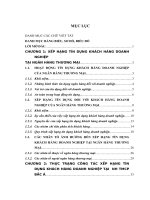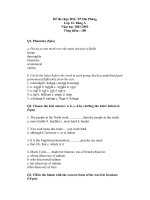practise reading bang a 2 doc
Bạn đang xem bản rút gọn của tài liệu. Xem và tải ngay bản đầy đủ của tài liệu tại đây (33.83 KB, 7 trang )
23. Why is fossilized bone heavier than
ordinary bone?
(A) Bone tissue solidifies with age.
(B) The marrow cavity gradually fills
with water
(C) The organic materials turn to
stone
(D) Spaces within the bone fill with
minerals.
24. The word “pores” in line 7 is closest in
meaning to:
(A) joints
(B) tissues
(C) lines
(D) holes
25. What can be inferred about a fossil
with a high degree of mineralization?
(A) It was exposed to large amounts
of mineral-laden water throughout
time.
(B) Mineralization was complete
within one year of the animal’s
death.
(C) Many colorful crystals can be
found in such a fossil.
(D) It was discovered in western
Canada.
26. Which of the following factors is most
important in determining the extent of
mineralization in fossil bones?
(A) The age of fossil
(B) Environmental conditions
(C) The location of the bone in the
animal’s body.
(D) The type of animal the bone came
from
27. Why does the author compare fossils
found in western Canada to those
found in Florida?
(A) To prove that a fossil’s age cannot
be determined by the amount of
mineralization.
(B) To discuss the large quantity of
fossils found in both places
(C) To suggest that fossils found in
both places were the same age.
(D) To explain why scientists are
especially interested in Canadian
fossils
28. The word “it” in line 24 refers to
(A) hydroxyapatite
(B) microscopic structure
(C) crystal structure
(D) modern bone
29. The word “detectable” in line 26 is
closest in meaning to
(A) sizable
(B) active
(C) moist
(D) apparent
30. Which of the following does NOT
survive in fossils?
(A) Noncollagen proteins
(B) Hydroxyapatite
(C) Collagen
(D) Amino acid
Line
(5)
(10)
(15)
(20)
(25)
Question 31 – 40
In the last third of the nineteenth century a new housing form was quietly being
developed. In 1869 the Stuyvesant, considered New York’s first apartment house was
built on East Eighteenth Street. The building was financed by the developer Rutherfurd
Stuyvesant and designed by Richard Morris Hunt, the first American architect to graduate
from the Ecole des Beaux Arts in Paris. Each man had lived in Paris, and each understood
the economics and social potential of this Parisian housing form. But the Stuyvesant
was at best a limited success. In spite of Hunt’s inviting façade, the living space was
awkwardly arranged. Those who could afford them were quite content to remain in the
more sumptuous, single-family homes, leaving the Stuyvesant to young married couples
and bachelors.
The fundamental problem with the Stuyvesant and the other early apartment buildings
that quickly followed, in the 1870’s and early 1880’s was that they were confined
to the typical New York building lot. That lot was a rectangular area 25 feet wide by 100
feet deep – a shape perfectly suited for a row house. The lot could also accommodate a
rectangular tenement, though it could not yield the square, well-lighted, and logically
arranged rooms that great apartment buildings require. But even with the awkward
interior configurations of the early apartment buildings, the idea caught on. It met the
needs of a large and growing population that wanted something better than tenements
but could not afford or did not want row houses.
So while the city’s newly emerging social leadership commissioned their mansions,
apartment houses and hotels began to sprout in multiple lots, thus breaking the initial
space constraints. In the closing decades of the nineteenth century, large apartment
houses began dotting the developed portions of New York City, and by the opening
decades of the twentieth century, spacious buildings, such as the Dakota and the Ansonia
finally transcended the tight confinement of row house building lots. From there it was
only a small step to building luxury apartment houses on the newly created Park Avenue,
right next to the fashionable Fifth Avenue shopping area.
31. The new housing form discussed in
the passage refers to
(A) single-family homes
(B) apartment buildings
(C) row houses
(D) hotels
32. The word “inviting” in line 7 is closest
in meaning to
(A) open
(B) encouraging
(C) attractive
(D) asking
33. Why was the Stuyvesant a limited
success?
(A) The arrangement of the rooms
was not convenient.
(B) Most people could not afford to
live there.
(C) There were no shopping areas
nearby.
(D) It was in a crowded neighborhood.
34. The word “sumptuous” in line 9 is
closest in meaning to
(A) luxurious
(B) unique
(C) modern
(D) distant
35. It can be inferred that the majority of
people who lived in New York’s first
apartments were
(A) highly educated
(B) unemployed
(C) wealthy
(D) young
36. It can be inferred that the typical New
York building lot of the 1870’s and
1880’s looked MOST like which of the
following?
37. It can be inferred that a New York
apartment building in the 1870’s and
1880’s had all of the following
characteristics EXCEPT:
(A) Its room arrangement was not
logical.
(B) It was rectangular.
(C) It was spacious inside.
(D) It had limited light.
38. The word “yield” in line 15 is closest in
meaning to
(A) harvest
(B) surrender
(C) amount
(D) provide
39. Why did the idea of living in an
apartment become popular in the late
1800’s?
(A) Large families needed housing
with sufficient space.
(B) Apartments were preferable to
tenements and cheaper than row
houses
(C) The city officials of New York
wanted housing that was centrally
located.
(D) The shape of early apartments
could accommodate a variety of
interior designs.
40. The author mentions the Dakota and
the Ansonia in line 24 because
(A) they are examples of large, well-
designed apartment buildings
(B) their design is similar to that of
row houses
(C) they were built on a single building
lot
(D) they are famous hotels
Line
(5)
(10)
(15)
(20)
Question 41 – 50
A snowfall consists of myriads of minute ice crystals that fall to the ground in the
form of frozen precipitation. The formation of snow begins with these ice crystals in the
subfreezing strata of the middle and upper atmosphere when there is an adequate
supply of moisture present. At the core of every ice crystal is a minuscule nucleus, a
solid particle of matter around which moisture condenses and freezes. Liquid water
droplets floating in the supercooled atmosphere and free ice crystals cannot coexist
within the same cloud, since the vapor pressure of ice is less than that of water. This
enables the ice crystals to rob the liquid droplets of their moisture and grow continuously.
The process can be very rapid, quickly creating sizable ice crystals, some of which
adhere to each other to create a cluster of ice crystals or a snowflake. Simple flakes
possess a variety of beautiful forms, usually hexagonal, though the symmetrical shapes
reproduced in most microscope photography of snowflakes are not usually found in
actual snowfalls. Typically, snowflakes in actual snowfall consists of broken fragments
and clusters of adhering ice crystals.
For a snowfall to continue once it starts, there must be a constant inflow of moisture
to supply the nuclei. This moisture is supplied by the passage of an airstream over a
water surface and its subsequent lifting to higher regions of the atmosphere. The Pacific
Ocean is the source of moisture for most snowfalls west of the Rocky Mountains, while
the Gulf of Mexico and the Atlantic Ocean feed water vapor into the air currents over
the central and eastern sections of the United States. Other geographical features also
can be the source of moisture for some snowstorms. For example, areas adjacent to the
Great Lakes experience their own unique lake-effect storms, employing a variation of
the process on a local scale. In addition, mountainous section or rising terrain can
initiate snowfalls by the geographical lifting of a moist airstream.
41. Which of the following questions does
the author answer in the first
paragraph?
(A) Why are snowflakes hexagonal?
(B) What is the optimum temperature
for snow?
(C) In which months does most snow
fall?
(D) How are snowflakes formed?
42. The word “minute” in line 1 is closest in
meaning to
(A) tiny
(B) quick
(C) clear
(D) sharp
43. What is at the center of an ice crystal?
(A) A small snowflake
(B) A nucleus
(C) A drop of water
(D) A hexagon
44. The word “adhere” in line 10 is closest
in meaning to
(A) belong
(B) relate
(C) stick
(D) speed
45. What is the main topic of the second
paragraph?
(A) How ice crystals form
(B) How moisture affects temperature
(C) What happens when ice crystals
melt
(D) Where the moisture to supply the
nuclei comes from
46. The word “it” in line 15 refers to
(A) snowfall
(B) snowflake
(C) cluster
(D) moisture
47. What is necessary for a snowfall to
persist?
(A) A decrease in the number of
snowflakes
(B) Lowered vapor pressure in ice
crystals
(C) A continuous infusion of moisture
(D) A change in the direction of the
airstream
48. How do lake-effect snowstorms form?
(A) Water temperature drop below
freezing.
(B) Moisture rises from a lake into the
airstream.
(C) Large quantities of wet air come off
a nearby mountain.
(D) Millions of ice crystals form on the
surface of a large lake.
49. The word “initiate” in line 24 is closest
in meaning to
(A) enhance
(B) alter
(C) increase
(D) begin
50. Which of the following could account
for the lack of snowfall in a
geographical location close to
mountains and a major water source?
(A) Ground temperatures below the
freezing point
(B) Too much moisture in the air
(C) Too much wind off the mountains
(D) Atmospheric temperatures above
the freezing point.
Practice Test A – Answers
Question Number Answer Level of Difficulty Answered Correctly
1 D Medium
65%
2 C Difficult 47%
3 A Medium 74%
4 C Medium 78%
5 D Easy 86%
6 A Difficult 40%
7 D Medium 67%
8 C Easy 88%
9 B Medium 75%
10 B Medium 63%
11 C Easy 84%
12 B Difficult 43%
13 C Difficult 43%
14 A Easy 82%
15 C Difficult 45%
16 A Medium 55%
17 D Medium 80%
18 D Difficult 48%
19 C Easy 86%
20 D Medium 75%
21 B Medium 62%
22 B Difficult 46%
23 D Medium 58%
24 D Medium 75%
25 A Medium 71%
26 B Medium 76%
26 A Easy 83%
28 A Easy 87%
29 D Medium 57%
30 C Medium 70%
31 B Medium 80%
32 C Difficult 45%
33 A Medium 60%
34 A Difficult 49%
35 D Medium 58%
36 D Medium 67%
37 C Difficult 46%
38 D Medium 65%
39 B Medium 61%
40 A Medium 68%
41 D Medium 82%
42 A Medium 74%
43 B Medium 78%
44 C Medium 69%
45 D Medium 63%
46 A Medium 80%
47 C Medium 71%
48 B Medium 71%
49 D Medium 57%
50 D Difficult 35%









